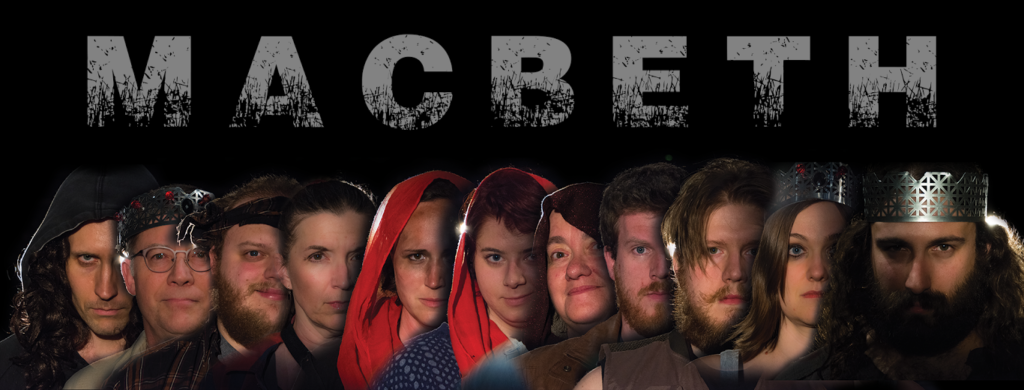To beguile the time, look like the time. Ambitiously and bolding tackling the Bard’s Scottish tragedy as their inaugural production, Susquehanna Shakespeare Ensemble brings Macbeth to the stage in a post-apocalyptic Scotland that exists only in a theatre of the audiences’ imagination. Directed by the company’s Founding Artistic Director, Marshall B. Garrett, the spirited pacing and judicious rendering of the five-act tragedy comes smoldering over the stage in just 90 minutes. Something wicked this way runs!
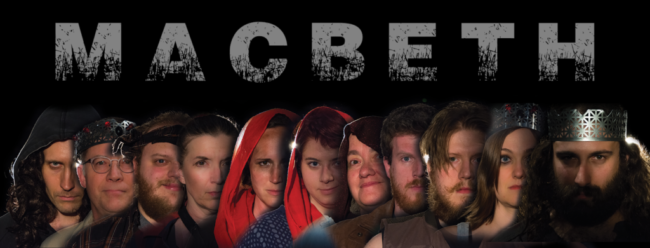
The scenery is non-existent. You won’t notice its missing you won’t care that it’s gone. The costumes, cleverly assembled by the cast, are grungy and modern, with strips and scraps of the iconic red Scottish plaid pattern accentuating a sash here, a bow there; every character possesses a hint of red at some point, the most striking among them being the bloody scarves draped around the necks of the three performers who double as the Weird Sisters, pulling these scarves up over their heads like gruesome hoods when they become the Fates. Noted here too is the blood FX featured on various members of the cast, whenever ‘tis appropriate, for its gory appearance and natural existence.
Macbeth in its extreme presentation is one bold risk, refusing lighting design is a secondary brazen choice that Director Marshall B. Garrett puts into play. Though a Lighting Designer is credited— Tyler “Danger” Bristow— the house lights remain up and the stage lighting remains neutral during the entirety of the performance, with darkness being used only to signify the beginning and end of the production. While the specific intent of this device is muddled, the actors draw you into their tale so thoroughly that after the first few moments you don’t notice, let alone mind. There are even moments when characters wend their way into the house— specifically The Porter (Debra McGuire) during the infamous “knock, knock, knock” speech, slurring her bawdy statements to members of the audience individually and directly.
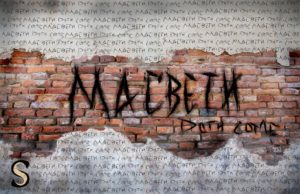
The production design element that is keenly felt— and more strongly heard— and most definitely present, serving as a guiding force of the production is the audio soundscape crafted and composed primarily by Musical Artist J. Andrew Dickenson. Enlisting the assistance of the ensemble with some of the pre-show instrument playing as well as the various spooky noises that correspond to certain characters and heightened moments of action during the performance, Dickenson composes some thoroughly haunting soundscapes that will linger in the mind’s ear the way the spirited weird sisters lurk ever-present just on the periphery of each scene. The “recyclables” wind-chime effect, which seems to announce the arrival and/or departure of the Fates, is just one of several unique and spine-tingling sound effects Dickenson puts to use over the course of the performance. A man of many hats— or in this case, one simple yet effective hood— Dickenson also appears in the performance as Seyton; his portrayal is eerily reminiscent of a Slender-Man type character, his nasally vocal affectation completing the unsettling delivery of his words.
A nod of praise must be given to Fight Choreographer Joe Grasso, who not only blocks all of the rigorously vigorous fight scenes but often stars in them as he portrays the title character, but more on that anon. The fighting, particularly the bloody attacks that fall into place as the play races toward its disastrously tragic conclusion are crisp and sharp, smacking of real-time action rather than the phony and overly dramatic stage choreography that is all too often used in more brutal fight scenes. There is an air of Shakespearean authenticity to Grasso’s work, a timeless feel to the way the characters bludgeon and beat upon one another until someone falls down dead.
Director Marshall B. Garrett swiftly and judiciously renders the fat and treacle from the Bard’s wordy drama, simmering its wicked essence into a pungent Shakespearean reduction ripe and ready to be drizzled over the rare and bloody steak that is Macbeth. For all of his valiant efforts, the plot and its major points clip along; the pacing crackles with an electric charge for all but one scene— the one shared between the blood-lusting Malcolm and the tranquil Macduff. This scene feels as if it goes on into eternity and is the only spot where superfluous inclusion presents itself as an issue in the drastic cuts that Marshall has made. The vision for this production that Marshall puts forth is otherwise quite striking. Cultivating unique and striking moments— like when Macbeth and Lady Macbeth crown themselves or the way the cauldron is created from members of the ensemble, each seizing the titular character during the final prophecy— Garrett puts a new and curious spin on the well-worn tragedy; this spin does not go unappreciated for despite his liberal edits, he and the company remain true to the text.
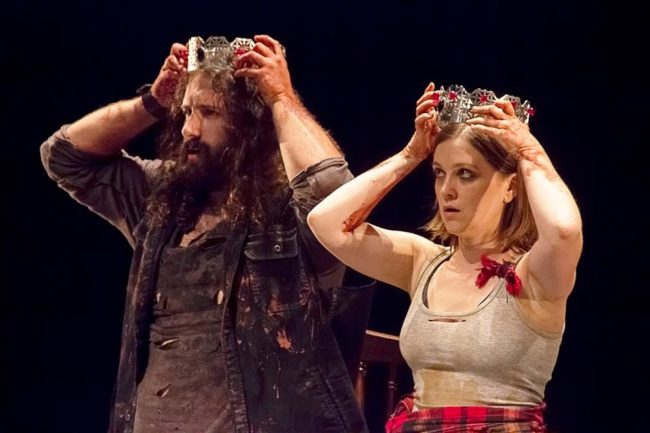
With a cast of just 11— including the musically inclined J. Andrew Dickenson who is mostly tucked away in a corner making surreal sound effects— the ensemble nature of the piece comes to the foreground, despite having a titular character as the show’s central focus. John Mulvey tackles the role of Duncan as well as Siward, among others, and does so with simplistic reverence. The same can be said of Karen Decker in her portrayal of Ross. Decker, excluding Joe Grasso in the titular role, is the only performer to take on only one role. Charlie Johnson deserves a nod of praise for her nerdy affectation of personality and voice when tackling Lennox. When he guises his face in an ominous mask, playing opposite of Debra McGuire, the pair become shadowy demons, assassins who lurk ready and waiting in the night.
McGuire, though serving as one of the three Weird Sisters, deserves praise for her role as the Porter, which is both aptly drunk and vibrantly bold. Sarah Sickles and Nina Krauss take up the remaining two thirds of the witches of fate, with Sickles taking on the roles of young Fleance, Donalbain, and Lady Macduff among others. Each portrayal therein draws from a unique specificity, setting each character apart from the others that she plays. Krauss, who plays the savagely inclined Malcolm, shows the drive of her blood-lust in the laborious scene shared with Macduff (Ryan Milliner.)
Milliner, who starts the production as the noble, albeit wounded Captain, surfaces later as the reverent and calm Macduff. At first his level-headed serenity is almost dull and bland, but when Milliner rises to the occasion of emotional overload and furious grief, there is such a jarring juxtaposition of the two veins of his character that it is mind blowing; this serves as an ultimate reward to the audience for accepting his mild-mannered initial portrayal of Macduff. Matthew Peterson, who plays the equally mild mannered Banquo, takes his two seconds of glory and fame not with any spoken text that the good man delivers, but rather in the infamous ghostly dinner scene. Rising from the chair like a zombie unhinged, Peterson stalks toward Macbeth and sends shivers out to the entire whole of the audience with his rigid and unyielding physicality.
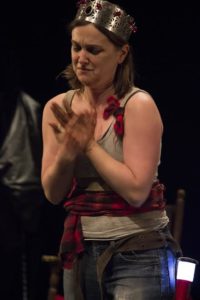
Lady Macbeth is indeed a challenge for any actor, Tess Garrett included. Though her enunciation and overall connection to the text is clear, there is drive lacking from her overall portrayal. A bit too sane and levelly portrayed during her “unsex me” monologue, Garrett never quite hits the various levels of fury and madness and corruption that are often coupled with the Lady Macbeth character. It is harrowing, however, to watch the simplicity of her facial expressions during the self-appropriated coronation scene and the even more stunning simplicity of her exit, which involves her simply walking off the stage.
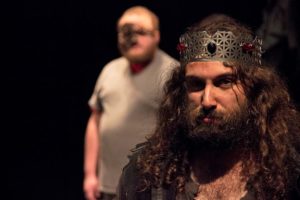
Joe Grasso takes Macbeth down Lear and Hamlet’s path; he follows the footfalls of madness early on and does a remarkable job of making it a believable part of the character’s inherent nature. Grasso approaches Macbeth with a desperate shred of sanity that tethers his words to his body but only briefly before delving into the full lunacy of power, corruption, and bloodlust. There is a steady build of this madness, which creeps in long before the banquet with Banquo scene, so that when his momentary explosion arrives it feels fully justified. Watching Grasso on the insanely driven warpath by the time the play winds into its conclusion is sensational; his responses to the text and those around him are both unusual and welcome.
Indeed off to a successful start with this ambitious and bold production of Macbeth, the Susquehanna Shakespeare Ensemble has several tricks up their sleeve that they cannot wait to share with you.
Running Time: Approximately 90 minutes with no intermission
Macbeth plays through May 28, 2017 at Susquehanna Shakespeare Ensemble currently performing at 1 Seahawk Drive in North East, MD. Tickets are available for purchase by calling the box office of the host venue at (410) 287-1037 or through purchase online.

